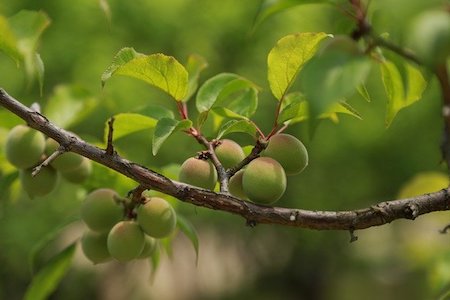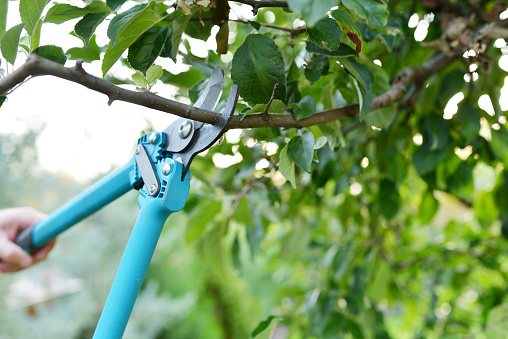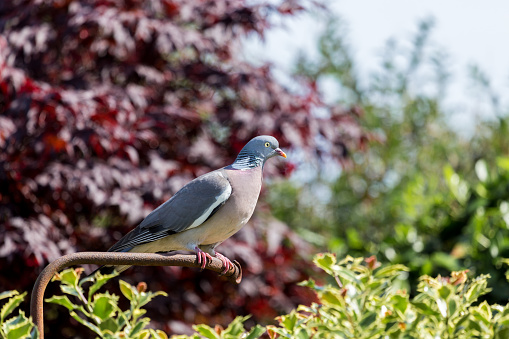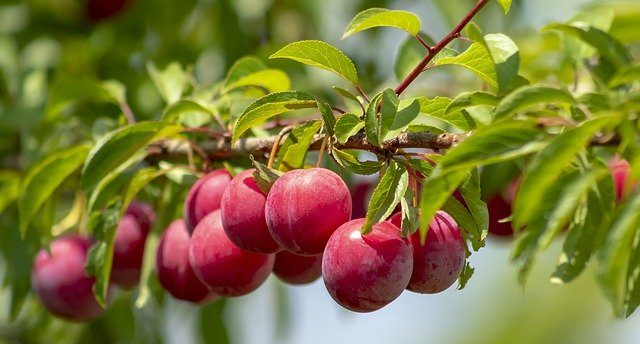Interested in growing plum trees? Of course, and why wouldn’t you be?
These hardy trees do well in the British climate, aren’t overly complicated to plant and grow, and yield delicious fruit for you to cook and prepare how you see fit.
There are even varieties of plum trees that are perfect for gardens that don’t have an abundance of space available, so what are you waiting for?
This guide will tell you everything you need to know to get started growing and looking after plum trees and will soon have you harvesting your very own home grown plums.
Where should I grow plums?
When picking a spot for your plum trees, keep in mind that they like a lot of sun, but they also need to be protected from the stronger winds that come around at certain times of the year. Because plum fruits are relatively heavy, they can be dislodged from the branch by strong winds before they are ripened and end up falling to the ground. Frosts can also damage the flowers on plum trees, so finding a nice sheltered spot that still gets plenty of sunshine is ideal.

If you decide to grow plum trees from semi-dwarfing rootstock, you shouldn’t need too much space, and as a lot of the cultivars available in the UK are self-pollinating, you should still get results from planting only a single tree. It is recommended that you plant at least one other though as this will produce better results, and check to make sure you have got a self-pollinating cultivar if only opting for a single tree.
What soil should I plant plum trees in?
Plum trees grow best in good clay soils or loamy soils, but there has to be good drainage. If you have overly sandy soil in your garden, or chalky soil, you can still plant plum trees but you will have to add some manure or compost beforehand. Always keep an eye on the soil to make sure it isn’t getting waterlogged, or it will affect the growth of the trees negatively.
When is the best time to plant plum trees?
As plum trees are dormant in winter, this is the best time to plant them. These trees will start to grow around late winter to early spring time. You can decide for yourself whether to plant directly into the soil or to grow in a container, but it is well known that bare root plants establish themselves better.
Do I need to prune my plum trees?
Plum trees do need pruning, but it is usually only a once a year job. Unlike many other fruit trees, plum trees are best pruned when at the height of their growth, which is in early summer. Make sure you prune during a spell of dry weather, and make your cuts on a sloping angle, as this will help moisture to run off. You want to completely remove any shoots that are growing in towards the centre of the tree, and prune the rest that are growing outwards so that they continue to grow the following year.

Also, remove any broken branches, but not completely. Just trim back to where they feel strong again. Never prune a plum tree in Autumn or winter as this leaves them vulnerable to silver leaf disease.
When do I harvest my plums?
You can tell when your fruit is ready to be harvested by simply giving them a light squeeze. If they feel soft to the touch, then they are likely ready to eat. Ripe plums can bruise quite easily, so it’s best to remove them from the tree with a little care.
What problems and pests can I expect with my plum trees?
Unfortunately, no plant or tree is free of problems, and plum trees have their own fair share.
As mentioned above, silver leaf disease is a common ailment. The main cause of this is pruning at the wrong time so be sure to follow our advice and avoid pruning in Autumn or Winter. You can tell when your tree has been affected by the disease by the silver sheen on the leaves, hence the name.
Plum moth is another thing to look out for. It’s not so much the moths themselves, but the maggots they leave behind inside the fruit. There is nothing you can really do once the moths have laid their larvae in the fruit so you have to take action beforehand.
Plum moth pheromone traps can reduce the numbers of the insects in the area, and are a better alternative, at least in my opinion, to spraying the fruit with chemicals.

Pigeons are known to damage plum trees by breaking the new branches and also tearing up the leaves. This damage can cause the tree not to produce fruit, so if you notice this happening in your garden, you need to keep those pesky pigeons away.
Thankfully, it is not that hard to scare pigeons away, and by simply hanging plastic bags, or something similar which flutters in the wind is usually enough to keep them off the branches.
If you notice greyish brown bumps appearing on the surface of your fruit, it’s most likely a case of brown rot. This disease doesn’t only affect the surface, but will also cause the inside of the fruit to rot away. This is a fungal disease that can be caused by a wide variety of things and is hard to prevent but if you keep a sharp eye out for the signs and then remove the infected fruit immediately, you should be able to control it.
It is important that you don’t leave the infected fruit on the ground after you have cut it away, and dispose of it properly. Leaving fruit on the tree too long after it has ripened can also invite the fungus in that causes brown rot, so harvest as soon as you can to prevent this happening.
